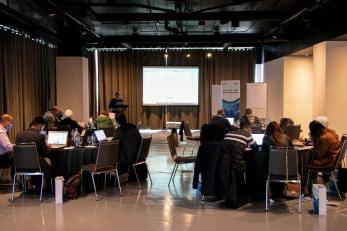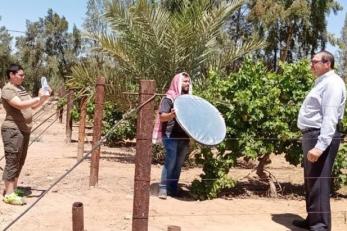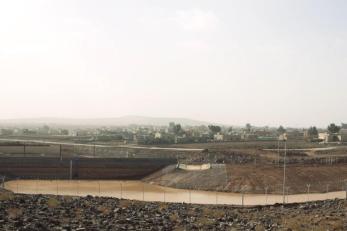Enhancing the capacities of equipment suppliers to design a water-efficient irrigation system

As primary actors in the agriculture technology market, irrigation equipment suppliers are critical players to facilitate change in water-use efficiency in the agriculture sector. In its efforts to increase the skills and knowledge of agriculture suppliers, the USAID Water Innovation Technologies (WIT) activity provides these suppliers with intensive training and awareness sessions to enhance their capacities to provide pre-and post-sales advisory services. In addition, WIT promotes the effective engagement between suppliers and farmers to spur demand for efficient irrigation technologies. Recently, WIT trained irrigation equipment suppliers on the use of software to design irrigation systems. Traditionally, irrigation networks are not scientifically designed to account for elements such as topography and existing networks, resulting in wasteful and inefficient water distribution.
Through various training sessions, the suppliers and government entities mastered the use of software that relies on scientific methods to design the layout of irrigation systems. This will enable suppliers to accurately identify the sizes of pipes, valves, pumps, and other network elements that are necessary to distribute water efficiently in order to minimize water losses. The software allows suppliers to give their customers access to customized irrigation system design services when installing or improving their irrigation networks. By enhancing suppliers’ capacities to provide technical pre-and post-sale advisory services, the suppliers are able to address the farmers’ most common irrigation challenges related to efficient water use; this will ultimately enable farmers to save on water and electricity costs and produce higher quality fruits.
USAID enhances farmers’ access to irrigation advice to conserve water

The USAID Water Innovation Technologies Project (WIT) helps farmers in two groundwater-dependent agricultural areas (Azraq and Mafraq) to save water resources and cut down on electricity bills by introducing water-efficient technologies and practices. The project links farmers to the private sector, specifically the suppliers of water-saving technologies and service providers to increase the irrigation efficiency by alleviating constraints on access to water-saving technologies. However, many farmers in Jordan lack information and advice on how to optimize irrigation systems, the availability of new irrigation technologies, and the costs and benefits of adopting improved water-saving practices and technologies in their farms.
To address the knowledge related-barriers, WIT has adopted a multi-pronged approach to increase farmers’ access to relevant irrigation-related advice from a variety of different market actors. For example, during this year, WIT developed factsheets about water requirements for crops in Mafraq and Azraq, and disseminated four educational videos to farmers covering technical topics such as irrigation network design, benefits of using low-flow emitters associated with proper filtration systems, irrigation system management and scheduling as well as financial returns of water-saving technologies. The project will continue to work with a diverse array of supporting market actors including input providers and wholesale agents, media outlets and government agencies to raise awareness of farmers to positively change and influence their behavior to adopt efficient irrigation practices and technologies.
USAID increases surface water catchment capacity in Ramtha and Mafraq

In an effort to reduce the stress over municipal water networks and the use of potable water for non-drinking purposes, USAID’s Water Innovation Technologies (WIT) Project has completed the rehabilitation of Al Buwaida rainwater retention structure in Ramtha and Deir Al Kahef rainwater retention structure in Mafraq. In preparation for the rehabilitation work, WIT facilitated consultations with local community leaders and stakeholders and conducted environmental studies to increase the capacity of the retention structures from 20,000 to 80,000 m³ of water in Al Buwaida and from 25,000 to 50,000 m³ of water in Deir Al Kahef. The interventions in each rainwater retention structure included establishing entry and exit access points for tankers to pump water safely, installation of double fences, lighting and floating tiers around the dam and the construction of a guardroom.
As a result of the rehabilitation work, the structures will be accessible to 155,692 residents in Ramtha and 14,700 residents in Mafraq, who will benefit from an alternative source of non-potable water for restricted irrigation, firefighting, construction, and livestock use. The structures will soon be handed over to the Ramtha and Mafraq municipalities under the supervision of the Jordan Valley Authority/Ministry of Water and Irrigation. By increasing the structure’s capacity and the amount of water available for non-potable uses, the stress on municipal water networks is reduced protecting Jordan’s vital water resources.